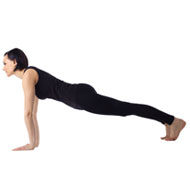- Aromatherapy (36)
- Benefits of Yoga (282)
- Home Remedies (1087)
- massage therapy (9)
- Preventive Therapy (135)
- Running (41)
- Skin Care (15)
- Stress Relief (25)
- Stretching (5)
- walking (33)
- Womens Health (14)
- Yoga Benefits for Pregnant Women (16)
- Yoga Benefits for Students (3)
- Yoga for Children (11)
- Yoga for Holistic Living (37)
- Yoga for Midlife Crisis (3)
- Yoga for Senior Citizens (2)
- Yoga for the Workplace (1)
- Yoga Health Tips (185)
- Yoga Practice during Menstruation (5)
Benefits Of Crocodile And Plank Pose In Yoga

The crocodile pose which is known as Makarasana and the plank pose are two different yoga postures. Let’s look at the crocodile pose and how it’s done.
Makarasana (The Crocodile Pose): A simple posture, the crocodile pose is relaxation posture. While doing this posture, the body resembles a crocodile, thus, it’s known as the crocodile pose. ‘Makar’ is the Sanskrit word for crocodile. A relaxation pose, Makarasana is done between other yoga pose to relax the body and calm the mind. For those who cannot lie on their back because of medical reasons, can do the crocodile pose to relax instead of the corpse pose.
Benefits Of The Crocodile Pose: There are several benefits of the crocodile pose –
- This pose relaxes the body and calms the mind.
- It lowers blood pressure and is good for people with hypertension and high blood pressure.
- The crocodile pose prevents scoliosis and flatulence.
This yoga asana is good for the digestion.
- It reduces tiredness after doing strenuous asanas and relaxes the muscles.
- This pose is good for those suffering from respiratory problems as the crocodile pose corrects and relieves breathing problems.
- Good for coping with anxiety and stress, the crocodile pose is good for curing insomnia.
The Plank Position (Kumbhakasana): The plank pose of yoga is basically aimed at strengthening the core of the individual as well as the arms, the abdominal muscles and the spine.
While the crocodile position is good for relaxation, the plank position good for those who want to strengthen their spine, back and arms. This yoga pose strengthens the upper body. While doing the crocodile pose, the body looks like that of a crocodile; in the plank pose the posture is that of the up position of a push-up. You have to keep your body in a straight line, without letting the buttocks sag. Your hands should be placed directly under your shoulders while performing this pose. You can hold the plank pose from anywhere from 15 seconds to 5 minutes.
Plank yoga is in fact usually practiced by individuals who are preparing themselves for even more challenging and complicated yoga poses that involve arm balances. While taking up the plank exercise one should gradually draw their torso forward from the downward facing dog pose to such an extent that their shoulders fall over their wrists and their entire body forms a straight line.In fact those practicing plank yoga often find that this pose is very similar to the position they would adopt whilst doing push ups. Thereafter, one should firmly press their hands and forearms down not allowing the chest to sink in and try and hold back by pressing onto their heels. The neck should be kept in line with the spine and the shoulder blades should be broadened so as to allow the individual to balance better and also work the right set of muscles.An advanced form of plank pose yoga would be to try and lift one leg at a time and hold the pose for a few seconds.
Side plank yoga is an advanced yoga pose that is also known as Vasisthasana. Over a period of time, with good amount of practice the individual will be able to gradually build into this pose. Some of the benefits of the side plank yoga pose that are often observed by those who have almost mastered this pose are a stronger core, increased tone in one’s legs and a highly improved sense of balance. Beginners to the side plank yoga pose should ideally practice this pose against a wall to gain a better sense of balance initially. However one should also note that those individuals who suffer from any ailments related to their shoulder or wrist should not practice this pose. While performing the side plank yoga pose one should ideally try and firm up the backs of their legs and also try and draw their shoulder blades down as this will help in strengthening the pose. An advanced form of the side plank yoga would include extending the upper leg up and out so that it is away from the supporting leg.
The Plank Pose is part of the sequence of positions in the Surya Namaskar (Sun Salutation). This pose can either be practiced as part of the Surya Namaskar or can be done individually.
Benefits Of The Plank Pose:
- The plank pose strengthens the wrists, arms, shoulders, spine and the back.
- This yoga posture tightens your abdominal muscles and develops the core strength of the body.
- The plank pose tones up the triceps.
- It is beneficial for the nervous system.
- RSS Feeds -
- All posts
- All comments
- Knock off the Back Bulge with Yoga If you have a back bulge or hangover of fat in the waistline area, you will want...
- Bedtime Yoga Poses If you have trouble sleeping at night and especially if your insomnia is stre...
- What is the secret to doing arm balance poses better? Yoga has hundreds of different poses called asanas that you do for improving you...
- Exercises For Scoliosis Scoliosis is a medical condition characterized by curvature of the spine. The...